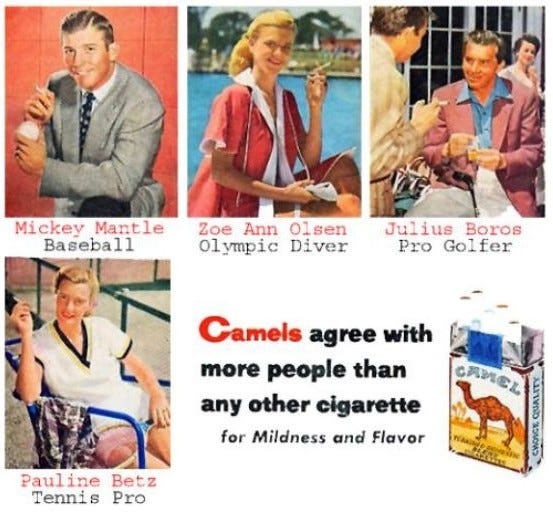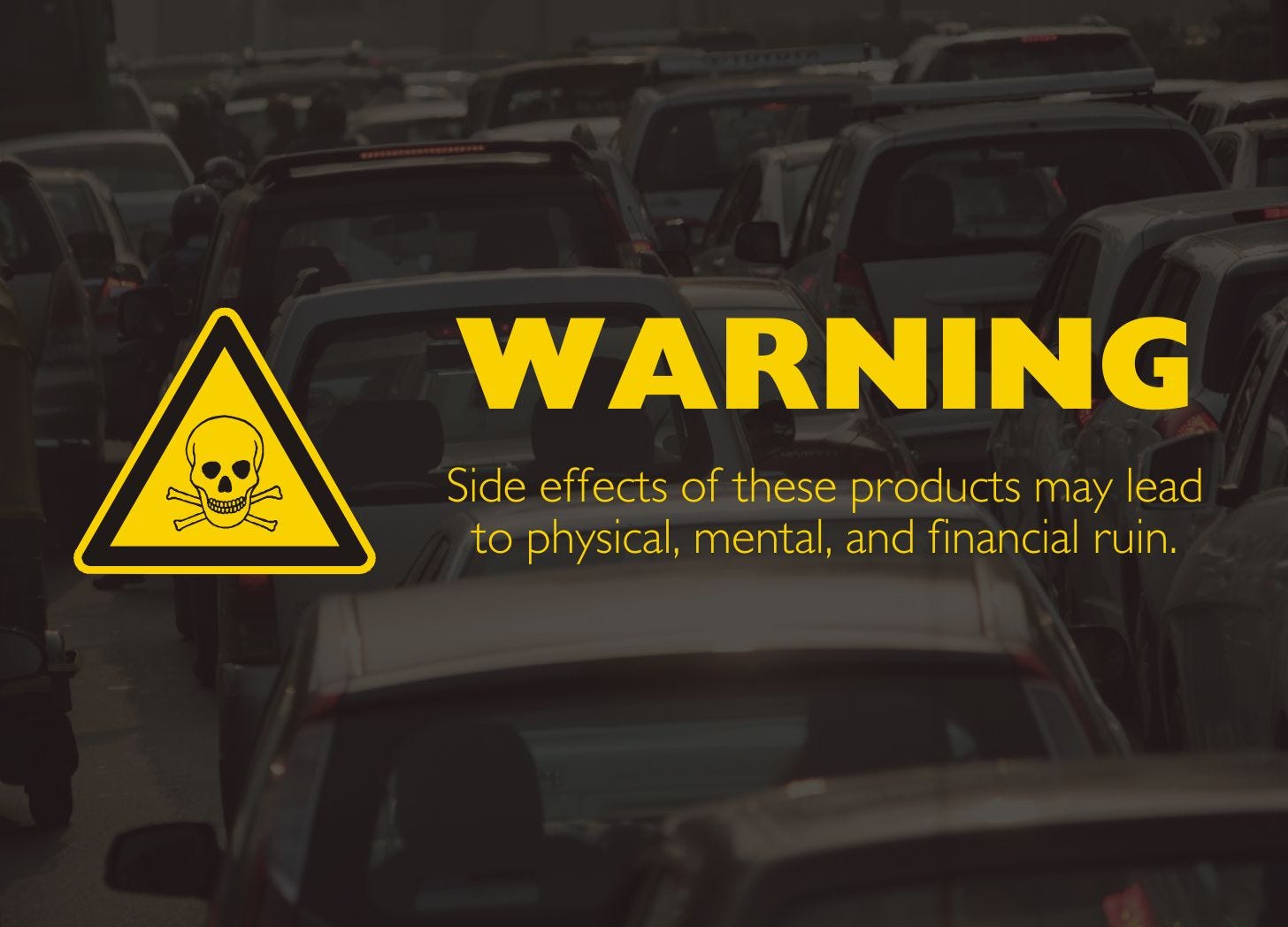You've been warned
If industries related to car dependency had to include a disclaimer about the side effects of their products, we'd have much more fruitful conversations about human flourishing.
I love learning about major turning points in history that were made possible or inevitable by propaganda. But my favorite sub-genre is 20th-century advertising. (I include public relations because it’s simply advertising a person or group’s work or opinion.) Advertising is a powerful force in shaping public opinion. It sells more than just products—it sells behaviors, aspirations, and even risk-taking.
Over the years, the pharmaceutical and tobacco industries faced scrutiny for manipulative advertising tactics that led to strict limits on what they can or can’t say about their products. And whatever they do claim, they have to print or read off a long list of potential side effects. It’s interesting that auto manufacturers get a pass on those types of warnings. Not to mention the professional planning industry that creates and sustains a landscape that keeps Americans dependent on the auto industry.
Warning labels are ubiquitous now, but it’s a relatively recent phenomenon tied to industrialization, consumer protection movements, and legal accountability. In the early 20th century, products rarely carried explicit warnings. Manufacturers assumed consumers bore the responsibility of understanding risks—like the hazards of early electrical appliances or patent medicines laced with opium or cocaine. Buyer beware.
The 1938 Federal Food, Drug, and Cosmetic Act mandated labeling for drugs and food to disclose contents and potential risks. This was spurred by tragedies like the 1937 Elixir Sulfanilamide disaster, where over 100 people died from a toxic solvent in an untested medicine. World War II accelerated industrial production, introducing complex machinery and chemicals into homes and workplaces with minimal guidance.
By the 1970s, warning labels proliferated as liability lawsuits surged. Cigarette packs got their first surgeon general warnings in 1966 ("Caution: Cigarette Smoking May Be Hazardous to Your Health"), evolving into stark "SMOKING KILLS" labels by the 21st century in some countries. The 1980s and '90s saw litigation-driven design—think McDonald’s "Caution: Hot Coffee" after the infamous 1994 spill lawsuit that Seinfeld spoofed.
Today, every prescription drug commercial includes a voiceover warning of potential side effects, either narrated at lightning speed or in a calm, friendly, Mr. Rogers tone. Most of them sound like dark comedy: “Take this pill if you want your skin to shine. Taking this pill might cause your skin to wrinkle, peel, crack, burn, or melt off your face.” Even medications with less serious risks have to disclose them: “Take this pill for a long romantic night. Taking this pill might make it hard for you to leave the house for a few hours even after the romance is over.”
Contrast this with automobile advertisements. An SUV or truck commercial doesn't have to mention the significantly higher fatality rate for pedestrians struck by large vehicles. Modern culture demands transparency for medicine but turns a blind eye to the deadliest consumer product in daily use: the motor vehicle.
There was a time when cigarette ads were everywhere. They had doctors recommending brands, cartoon mascots appealing to children, and rugged cowboys making smoking look cool.
As evidence piled up about cancer, addiction, and deliberate corporate cover-ups, it became socially unacceptable to actively promote cigarettes. Today, tobacco companies can’t advertise on TV or radio, and cigarette packaging includes graphic warnings about what the product can do to your body.
For decades, traffic crashes have been one of the leading causes of death for children. And even for people who survive crashes, the financial impact is devastating. Speed is a fundamental factor in severe traffic crashes, which is something you’d never deduce from car commercials. They’re flying around city streets with no trace of other people driving, walking, riding bikes, or waiting at the bus stop. You don’t hear about unhealthy side effects in the ads for the latest Ford or Toyota products. But I’m probably not saying anything you haven’t thought of before.
How about the Big Plan industry? For 100 years, local governments have written and enforced regulations that make car dependency inescapable. We have a policy product (zoning) that all but guarantees we have to use a mobility product (automobiles). You don’t see a warning label on your local government’s marketing material for the latest land use plan.
Zoning codes—those dense, technical rules dictating land use—are a product delivered to communities by local planners. Like a consumer good, zoning shapes daily life: where big houses can go, where little houses can go, where retail can go, where schools and churches can go…the status quo zoning regulations require everything to be sprawled out across creation. The auto industry is one of the biggest beneficiaries of the planning industry’s products. You tell yourself you drive because it’s most convenient, but that’s because Big Plan outlaws walk-friendly development patterns. It’s impossible to calculate the negative economic impact that zoning laws have had on Americans.
Maybe it’s not such a bad idea if urbanism-related industries faced restrictions on their propaganda campaigns similar to Big Pharma and Big Tobacco. Let’s start the brainstorming exercise!
WARNING: Driving at high speeds increases your risk of fatal crashes.
WARNING: This vehicle’s weight and height increase the likelihood of pedestrian death in a crash.
WARNING: Increased horsepower encourages dangerous driving behaviors.
WARNING: Large blind spots in this vehicle reduce visibility of children and cyclists.
WARNING: SUVs and trucks are more likely to roll over in crashes than smaller vehicles.
WARNING: This project will increase congestion within five years due to induced demand.
WARNING: More roads mean more vehicle miles traveled, leading to greater public health risks.
WARNING: Increased road capacity leads to higher long-term costs for taxpayers.
WARNING: More lanes increase the likelihood of high-speed crashes and severe injuries.
WARNING: Zoning laws lock in car dependency for generations.
WARNING: Restrictive zoning regulations contribute to housing shortages and affordability crises.
WARNING: Suburban sprawl increases infrastructure costs, passed on to taxpayers.
WARNING: Low-density zoning encourages longer commutes and higher transportation expenses.
WARNING: Car-centric planning reduces walkability and livability in neighborhoods.






As a medical professional, I've recently had to do some continuing education modules about the opioid crisis/epidemic, and the breathless announcement that over 42,000 people died in a single year from opiate overdoses sometime since 2020 frankly made me pretty angry. It's true and it's sad that those deaths occurred but it's also infuriating that the medical community is getting all worked up about this opioid death number and yet there is NOTHING, no continuing ed, no anguish, no advocacy, about those kinds of numbers of people killed (not to mention injured) EVERY YEAR for DECADES by CARS. What the H* are we thinking???
Brings to mind a great quote from Robert De Niro in Zero Day, along the lines that freedom allows people to do whatever they want, while liberty protects others from those actions. We need more of this kind of liberty when it comes to protecting people from cars and drivers.